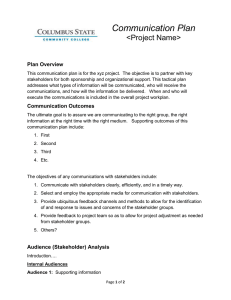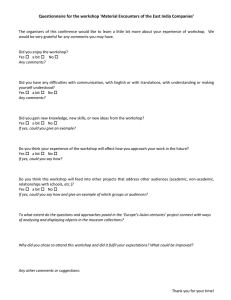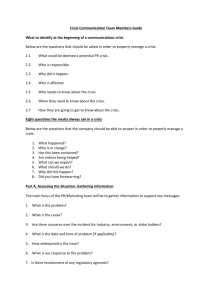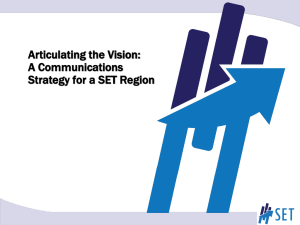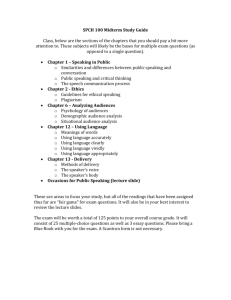SWPP LESSON PLAN SESSION: Source Water Protection Plans – Components and Process
advertisement
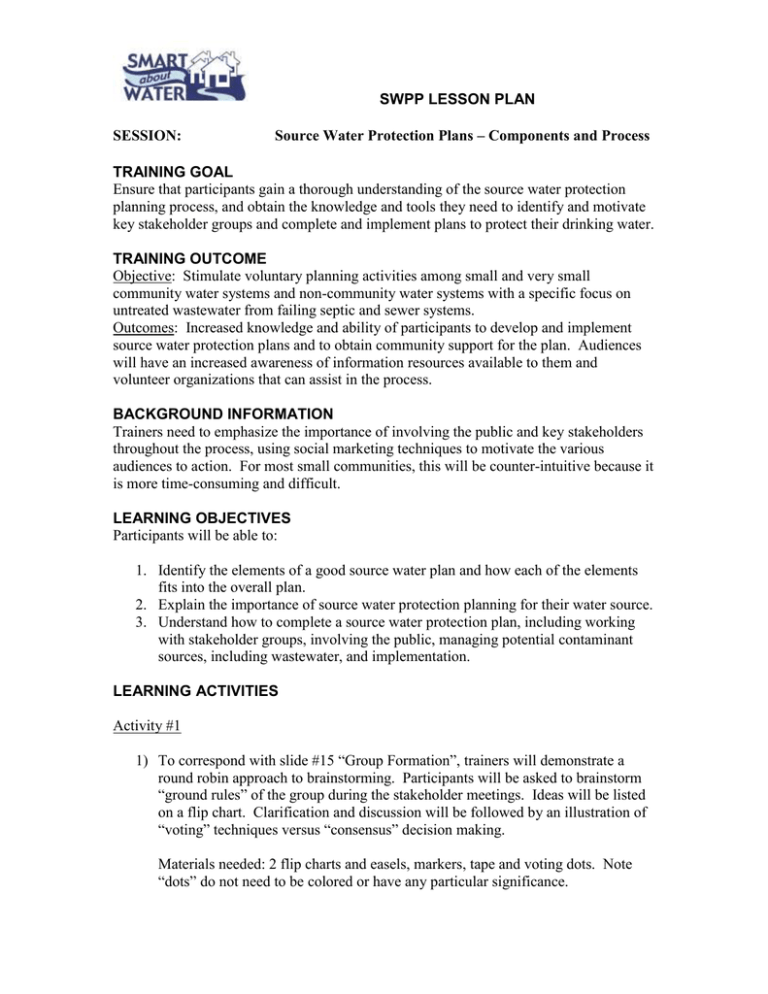
SWPP LESSON PLAN SESSION: Source Water Protection Plans – Components and Process TRAINING GOAL Ensure that participants gain a thorough understanding of the source water protection planning process, and obtain the knowledge and tools they need to identify and motivate key stakeholder groups and complete and implement plans to protect their drinking water. TRAINING OUTCOME Objective: Stimulate voluntary planning activities among small and very small community water systems and non-community water systems with a specific focus on untreated wastewater from failing septic and sewer systems. Outcomes: Increased knowledge and ability of participants to develop and implement source water protection plans and to obtain community support for the plan. Audiences will have an increased awareness of information resources available to them and volunteer organizations that can assist in the process. BACKGROUND INFORMATION Trainers need to emphasize the importance of involving the public and key stakeholders throughout the process, using social marketing techniques to motivate the various audiences to action. For most small communities, this will be counter-intuitive because it is more time-consuming and difficult. LEARNING OBJECTIVES Participants will be able to: 1. Identify the elements of a good source water plan and how each of the elements fits into the overall plan. 2. Explain the importance of source water protection planning for their water source. 3. Understand how to complete a source water protection plan, including working with stakeholder groups, involving the public, managing potential contaminant sources, including wastewater, and implementation. LEARNING ACTIVITIES Activity #1 1) To correspond with slide #15 “Group Formation”, trainers will demonstrate a round robin approach to brainstorming. Participants will be asked to brainstorm “ground rules” of the group during the stakeholder meetings. Ideas will be listed on a flip chart. Clarification and discussion will be followed by an illustration of “voting” techniques versus “consensus” decision making. Materials needed: 2 flip charts and easels, markers, tape and voting dots. Note “dots” do not need to be colored or have any particular significance. Time needed: 20 minutes Activity #2 2) To correspond with slide #37, trainers will illustrate another brainstorming technique in relation to generating and prioritizing potential management strategies. Participants will be asked to generate a list of five protection strategies (trainers will provide the sample potential contaminant source) each noted separately on a post it note. Then all participants will be asked to “place” their potential strategies on a decision grid (will have demonstration grid on easel) based on ease of implementation and level of potential benefit derived. After discussion and grouping if needed, participants will be asked to vote and/or develop consensus around top priority strategies. Materials needed: Same as above in addition to post it notes. Time needed: At least 30 minutes KEY MESSAGES FOR DIFFERENT TARGET AUDIENCES Remember to craft your messages and your training to the particular audience that you’re dealing with and to consider their wants, needs, and motivators. While this portion of the presentation is geared heavily toward local officials in the presumption that they will frequently be the ones initiating the planning process, it is easily adaptable to other audiences. Learning as much as possible about your audience and their local issues prior to your training session will help you better identify their needs and target your message. SUGGESTED HANDOUTS In conducting the training for your local audience, try to provide a balance in how much information you give them. Provide them with enough information to get them started on the process, but don’t bog them down with too much information or it won’t get used. If your state has prepared a good guidance document for completing a source water protection plan, you will certainly want to include that. Provide other handouts that are short and to the point. Sample plans, sample management strategies, and media samples are always very helpful for small communities. POSSIBLE AGENDA: It’s a good idea to provide your training participants with an agenda so they know what to expect in the session. The agenda generally provides a list of topics and the associated amount of time you plan to spend on the topic. You’ll note that this SMART Agenda builds in time for participants to complete the “Participant Sign-In Sheets, and to administer the Pre-evaluation and Post-evaluation Forms. It is critical to dedicate time during the session for training participants to complete these evaluation instruments. SAMPLE AGENDA: Source Water Protection Planning: Components and Process Approximate Time to Deliver Session: ____ hours/minutes 2 Welcome and Introductions Complete Registration Form Complete Pre-assessment Topic A Topic B Topic C Activity # Other Administer Post-assessment Summary and Feedback ____ minutes ____ minutes ____ minutes ____ minutes ____ minutes ____ minutes ____ minutes ____ minutes ____ minutes ____ minutes POWERPOINT AND CONTENT: For the Source Water Protection Planning session, two sets of PowerPoint Presentations have been developed. One is for use in a train-the-trainer situation. The other is more appropriate for community audiences. Both versions can be used as they are or adapted to meet your local needs. Detailed content to be taught is listed in the “Notes” section of each version of the PowerPoints. Electronic copies of the PowerPoints are located on the SMART PowerPoint CD-ROM. 3
